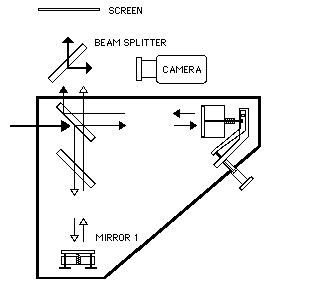White Light Interference
From UO Physics Demonstration Catalog
Revision as of 10:23, 25 April 2022 by Physdemo (talk | contribs) (Created page with "{{NewDemo|subject=Light and Optics|topic=Diffraction and Interference|file1=White Light Interference.gif}} Set up the interferometer with the laser by adjusting mirror 1 until the center of the diffraction pattern comes into view (see: Michelson Interferometer). Replace the laser with a white light source. The white light interference pattern (color bands) has been found at 16.1 ą .1 on the Vernier scale. Be aware that there is a very small range over which the interfe...")
Return to Diffraction and Interference
Description:
Set up the interferometer with the laser by adjusting mirror 1 until the center of the diffraction pattern comes into view (see: Michelson Interferometer). Replace the laser with a white light source. The white light interference pattern (color bands) has been found at 16.1 ą .1 on the Vernier scale. Be aware that there is a very small range over which the interference pattern occurs. Take time to set things up well and adjust the Vernier scale very slowly. If using a projector for the white light source the image shows up on a screen very well. A frosted 7.5 watt 120V incandescent bulb also gives excellent results but the camera must be used to display the effect to a group. The beam splitter helps to reduce the intensity of the beam for use with a camera.
Location:
- Interferometer: N-2
